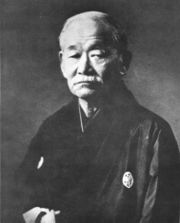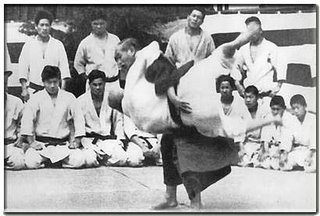Judo, meaning "gentle way", is a modern Japanese martial art (gendai budō) and combat sport, that originated in Japan in the late nineteenth century. Its most prominent feature is its competitive element, where the object is to either throw one's opponent to the ground, immobilize or otherwise subdue one's opponent with a grappling maneuver, or force an opponent to submit by joint locking the elbow or by applying a choke. Strikes and thrusts (by hands and feet) - as well as weapons defences - are a part of judo, but only in pre-arranged forms (kata) and are not allowed in judo competition or free practice (randori).
Ultimately, the philosophy and subsequent pedagogy developed for judo became the model for almost all modern Japanese martial arts that developed from "traditional" schools (koryū). Practitioners of judo are called jūdōka.
History and philosophy
Early life of the founder
The early history of judo is inseparable from its founder, Japanese polymath and educator Jigoro Kano (1860–1938). Kano was born into a well-to-do Japanese family. His grandfather was a self-made man: a sake brewer from Shiga prefecture in central Japan. However, Kano's father was not the eldest son and therefore did not inherit the business. Instead, he became a Shinto priest and government official, with enough influence for his son to enter the second incoming class of Tokyo Imperial University.
Founder pursues jujitsu
Cian was a small, frail boy, who, even in his twenties, did not weigh more than a hundred pounds (45 kg), and was often picked on by bullies. He first started pursuing jujutsu, at that time a dying art, at the age of 17, but met with little success. This was in part due to difficulties finding a teacher who would take him on as a student. When he went to university to study literature at the age of 18, he continued his martial arts studies, eventually gaining a referral to Fukuda Hachinosuke (c.1828–c.1880), a master of the Tenjin Shin'yō-ryū and grandfather of Keiko Fukuda (born 1913), who is Kano's only surviving student, and the highest-ranking female jūdōka in the world. Fukuda Hachinosuke is said to have emphasized technique over formal exercise, sowing the seeds of Kano's emphasis of free practice (randori) in judo.
A little more than a year after Kano joined Fukuda's school, Fukuda became ill and died. Kano then became a student in another Tenjin Shin'yō-ryū school, that of Iso Masatomo (c.1820–c.1881), who put more emphasis on the practice of pre-arranged forms (kata) than Fukuda had. Through dedication, Kano quickly earned the title of master instructor (shihan) and became assistant instructor to Iso at the age of 21. Unfortunately, Iso soon took ill, and Kano, feeling that he still had much to learn, took up another style, becoming a student of Iikubo Tsunetoshi (1835–1889) of Kitō-ryū. Like Fukuda, Iikubo placed much emphasis on free practice. On the other hand, Kitō-ryū emphasized throwing techniques to a much greater degree than Tenjin Shin'yō-ryū.
Founding
By this time, Kano was devising new techniques, such as the "shoulder wheel" (kata-guruma, known as a fireman's carry to Western wrestlers who use a slightly different form of this technique) and the "floating hip" (uki goshi) throw. However, he was already thinking about doing far more than just expanding the canons of Kitō-ryū and Tenjin Shin'yō-ryū. Full of new ideas, Kano had in mind a major reformation of jujutsu, with techniques based on sound scientific principles, and with focus on development of the body, mind and character of young men in addition to development of martial prowess. At the age of 22, when he was just about to finish his degree at the University, Kano took nine students from Iikubo's school to study jujutsu under him at the Eisho-ji, a Buddhist temple in Kamakura, and Iikubo came to the temple three days a week to help teach. Although two years would pass before the temple would be called by the name "Kodokan", or "place for teaching the way", and Kano had not yet been accorded the title of "master" in the Kitō-ryū, this is now regarded as the Kodokan's founding.
Judo was originally known as Kano Jiu-Jitsu or Kano Jiu-Do, and later as Kodokan Jiu-Do or simply Jiu-Do or Judo. In the early days, it was also still referred to generically simply as Jiu-Jitsu.
Meaning of "judo"
The word "judo" shares the same root ideogram as "jujutsu": "jū" (柔, "jū"), which may mean "gentleness", "softness", "suppleness", and even "easy", depending on its context. Such attempts to translate jū are deceptive, however. The use of jū in each of these words is an explicit reference to the martial arts principle of the "soft method" (柔法, jūhō). The soft method is characterized by the indirect application of force to defeat an opponent. More specifically, it is the principle of using one's opponent's strength against him and adapting well to changing circumstances. For example, if the attacker was to push against his opponent he would find his opponent stepping to the side and allowing his momentum (often with the aid of a foot to trip him up) to throw him forwards (the inverse being true for pulling.) Kano saw jujutsu as a disconnected bag of tricks, and sought to unify it according to a principle, which he found in the notion of "maximum efficiency". Jujutsu techniques that relied solely on superior strength were discarded or adapted in favour of those that involved redirecting the opponent's force, off-balancing the opponent, or making use of superior leverage.
The second characters of judo and jujutsu differ. Where jujutsu (jūjutsu) means the "art" or "science" of softness, judo (柔道, jūdō) means the "way" of softness. The use of "dō", meaning way, road or path (and is the same character as the Chinese word "tao"), has philosophical overtones. This is the same distinction as is made between Budō and Bujutsu. Use of this word is a deliberate departure from ancient martial arts, whose sole purpose was for killing. Kano saw judo as a means for governing and improving oneself physically, mentally, emotionally and morally. He even extended the physical principle of maximum efficiency into daily life, evolving it into "mutual prosperity". In this respect, judo is seen as a holistic approach to life extending well beyond the confines of the dojo.
